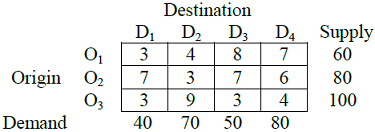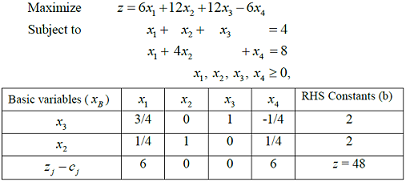GATE 2017-2018 :: GATE Mathematics
- Using Euler's method taking step size = 0.1, the approximate value of y obtained corresponding to x = 0.2 for the initial value problem dy/dx = x2 + y2 and y(0) = 1, is
-
The following table gives the unit transportation costs, the supply at each origin and the demand of each destination for a transportation problem.
 Let xij denote the number of units to be transported from origin i to destination j. If the u-v method is applied to improve the basic feasible solution given by x12 = 60, x22 = 10, x23 = 50, x24 = 20, x31 = 40 and x34 = 60, then the variables entering and leaving the basis, respectively, are
Let xij denote the number of units to be transported from origin i to destination j. If the u-v method is applied to improve the basic feasible solution given by x12 = 60, x22 = 10, x23 = 50, x24 = 20, x31 = 40 and x34 = 60, then the variables entering and leaving the basis, respectively, are -
Consider the system of equations
 .Using Jacobi's method with the initial guess [x(0) y(0) z(0)]T = [2.0 3.0 0.0]T, the approximate solution [x(2) y(2) z(2)]T after two iterations, is
.Using Jacobi's method with the initial guess [x(0) y(0) z(0)]T = [2.0 3.0 0.0]T, the approximate solution [x(2) y(2) z(2)]T after two iterations, is -
The optimal table for the primal linear programming problem:
 If y1 and y2 are the dual variables corresponding to the first and second primal constraints, then their values in the optimal solution of the dual problem are, respectively,
If y1 and y2 are the dual variables corresponding to the first and second primal constraints, then their values in the optimal solution of the dual problem are, respectively, -
The optimal table for the primal linear programming problem:
 If the right hand side of the second constraint is changed from 8 to 20, then in the optimal solution of the primal problem, the basic variables will be
If the right hand side of the second constraint is changed from 8 to 20, then in the optimal solution of the primal problem, the basic variables will be -
Consider the Fredholm integral equation
 .The resolvent kernel R(x, t; λ) for this integral equation is
.The resolvent kernel R(x, t; λ) for this integral equation is -
Consider the Fredholm integral equation
 .The solution of this integral equation is
.The solution of this integral equation is -
The joint probability density function of two random variables X and Y is given as
 E(X) and E(Y) are, respectively,
E(X) and E(Y) are, respectively, -
Consider the functions f(z) = (z2 + αx)/(z + 1)2 and g(z) = sinh(z - π/2α), α≠0The residue of f (z) at its pole is equal to 1. Then the value of α is
-
Consider the functions f(z) = (z2 + αx)/(z + 1)2 and g(z) = sinh(z - π/2α), α≠0For the value of α obtained in Q.54, the function g(z) is not conformal at a point


 Whatsapp
Whatsapp
 Facebook
Facebook

